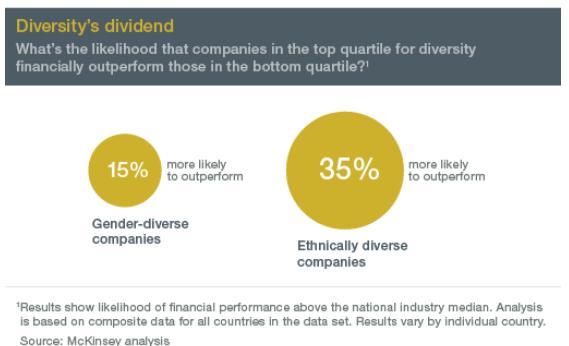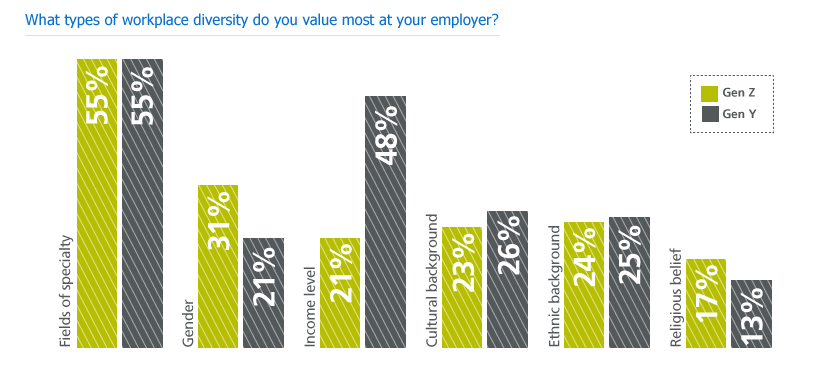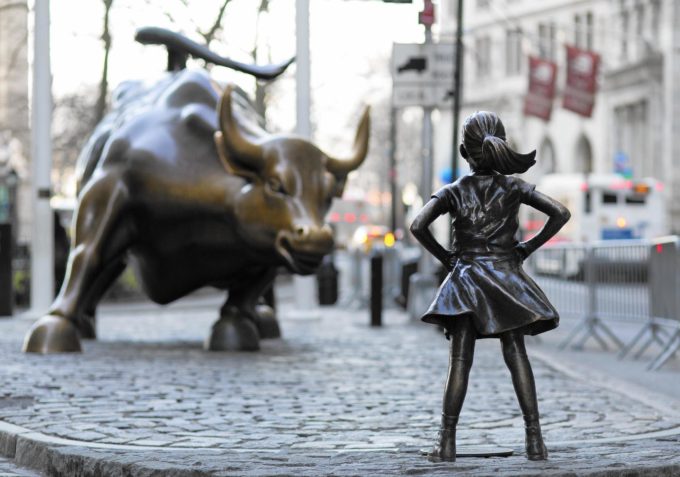 A recently installed sculpture, called “Fearless Girl,” has become both a viral sensation and an instantaneous icon of both gender equality and societal subversion.
A recently installed sculpture, called “Fearless Girl,” has become both a viral sensation and an instantaneous icon of both gender equality and societal subversion.
The sculpture was commissioned by a large Wall Street asset management firm to commemorate the start of International Women’s Day, when millions of other “Fearless Girls” took to the streets to protest the status quo and the inequities so many are forced to face in every aspect of their personal and professional lives.
The sculpture, of a young girl staring down the famous bull statue that’s long been a fixture in front of the NYSE, is meant to symbolize the endemic inequality women face in the workplace.
Specifically, “Fearless Girl” was designed to embody the growing, gender based pay gap that’s become so persistently pervasive throughout the financial services industry, as well as the dearth female representation on the corporate boards whose best interests this industry is explicitly designed to serve.
Spring Awakening: Diversity Gets #Woke.
The problem of a lack of equal opportunities and leadership roles for women, of course, extends far past Wall Street, with implications for every workplace (and worker) whose lives and livelihoods are adversely impacted simply because they happen to be a member of a protected class, whether that’s race, gender or even age.
“Fearless Girl” is a powerful example of guerrilla marketing, and her presence has opened myriad conversations about the lack of diversity of all forms in the workplace. Which raises the question: why are we still talking about this issue – and why haven’t companies still haven’t solved the endemic issues surrounding diversity and inclusion, even after all this time.
While the “Fearless Girl” sculpture remains powerful in its symbolism, the fact that she’s affixed in the same spot, unable to move forward and affect change seems equally apropos when describing the current state of workplace diversity today.
Given the fact that HR has, like the Light Brigade, approached its charge of fixing diversity as “full of sound and fury, but signifying nothing,” what’s it going to take for companies to finally fix what’s broken in diversity and inclusion?
I Believe: Why Diversity’s Early Champions Still Persisted.
The issue of workplace diversity is anything but a new one; in fact, it’s been over 50 years since President John F. Kennedy first signed the Equal Pay Law into law, making “equal pay for equal work” the law of the land, an act that remains in force even today.
In the intervening years since this landmark legislation was first passed, the legal protections first extended based on gender have evolved and expanded to cover almost every protected class, from race and religion to, more recently, veteran or disability status.
Given the seemingly singular focus of the HR profession on compliance and risk mitigation, the scattered and glacial adoption of workplace diversity programs has been surprisingly slow, not only given the associated liabilities companies face from non-compliance, but also, because the benefits of diversity and inclusion on business outcomes and the bottom line are so well documented by now.
It’s obvious that diversity and inclusion are just good business. More importantly, though, it’s equally obvious that it’s the right thing to do, too – and every employer should have long ago jumped on board, buy in which would have long ago rendered this as moot a point as most other civil rights actions that we now take for granted.
The problem, however, was that while there seemed to be some consensus around compliance issues, not every company wanted to admit that the early adopters of formal diversity programs were experiencing any real long term business benefit.
The same goes for the long held belief that cultural intelligence, the desired byproduct of successful D&I programs, might lead to better understanding how different cultural groups think and operate, but that the long-term benefits of these initiatives were insignificant when compared to the direct and indirect costs associated adoption. This myopic view has proven to be fundamentally flawed – and many employers are only now being forced to pay the costs of hubris.
While change has been glacial at best, the long term impact of diversity at the companies that truly committed not just the letter of the law, but also its spirit, has been nothing short of unprecedented.
This isn’t merely anecdotal evidence, either – when you do the math ,diversity makes both dollars and sense.

It isn’t hard to see that the market’s most diverse companies have seen consistent and significant increases in such quantifiable outcomes as employee engagement, worker productivity, customer satisfaction and, most prominently, increased revenues and bigger profits – and that’s the bottom line for any business.
Consider, for example, that simply replacing a skilled employee can cost a company between 25-200% of the employee’s annual salary, and you get a sense of just how asinine and irresponsible losing top talent due to exclusionary or inequitable personnel practices can be.
Year after year, study after study, one thing becomes clear: the positive impact of diversity and inclusion is not only statistically significant, but one of the drivers most strongly correlated with positive business and bottom line results.
If there’s a silver lining in the entrenched resistance to diversity programs and inclusion initiatives at many companies, however, it’s that those enterprises that have successfully built diverse and truly inclusive workforces were not only doing the right thing, but also gaining a competitive advantage over their less progressive competitors.
Karma is a funny thing, but the advantage these early adopters unexpectedly enjoyed was so significant that it wasn’t long before diversity began moving out of the “company values” category into a prominent position in the “strategic operations” column.
The payoff has been nothing short of profound.

This differentiated approach and philosophical shift around diversity not only maximized the many advantages of having a more inclusive and heterogeneous workforce, but changed the way companies looked at their talent, diverse or otherwise.
By the 1990s, most employers had already adopted and standardized taxonomies to identify the wide range of personal identifiers and demographic labels included in, well, inclusion that made diversity anything but a black and white issue.
Per a relatively recent report from global consulting giant Deloitte, these had become codified to include categories as broad as ethnicity, religion, sexual orientation, physical ability and sexual orientation, broadening the scope of their diversity efforts well past what’s required to ensure EEOC/AA/EOE compliance.
As Deloitte notes, having a formal diversity program didn’t simply compel companies to expand their search for qualified candidates, but it gave them permission (implicit and explicit) to drive hiring innovation and adopt a more strategic approach to talent acquisition, leading to better business alignment and improved recruiting efficiency and efficacy, too.
What began as largely “good faith” hiring efforts have given many employers good faith in recruiters, too, reallocating resources and headcount accordingly. Diversity enabled recruiters to stop pushing paper and start finding people, and that has made all the difference when it comes to the evolution of talent acquisition.
It’s a new world of work, and diversity has more or less moved from competitive advantage to business imperative. Still, many companies continue to resist this change, dismissing diversity as a trend, or an anomaly, more motivated by PC than P/L and destined to go the way of the Dodo sooner rather than later are closest to going extinct. Meanwhile, the most diverse companies are not only surviving, but thriving – and almost unilaterally running circles around their less diverse competition.
Business is learning what biologists have long known: the key to long term survival is diversification, adaptability and symbiosis – all of which are central precepts in the case for diversity in hiring, too.
Recruiting is evolving, and when it comes to the survival of the fittest, the choice has never been more clear: diversify or die. The answer should be obvious to anyone.
[youtube url=”https://www.youtube.com/watch?v=SpDImstABds” width=”500″ height=”300″]
Those You’ve Known: Why The World Is Becoming More Diverse.
Fun fact: “Generations,” the seminal sociological (if scientifically suspect) treatise by William Strauss and Neil Howe, the book that gave birth to the word “Millennials” (and a booming cottage industry of related “thought leaders,” pundits and prognosticators), was first published all the way back in 1991.
In attempting to define the growing generational gap in the workplace (and beyond), Strauss and Howe defined a “social generation” as “the aggregate of all people born over a span of roughly twenty years.” This means that we’ve actually been talking about the potential impact of Gen Y workers for well over a generation.
In the 26 years since Generations was first published, Millennials have indeed come of age, and currently represent the largest segment of the US labor market, having displaced their Gen X counterparts in Q1 2015, according to a Pew Research study, That same study suggested workers born between 1981-1997 will represent over 50% of all workers no later than 2020 (or less than 3 years from now, weird as that sounds).
When it comes to Gen Y workers, the future is now – which means now, more than ever, diversity and inclusion aren’t just important for employers – they’re a business imperative, period. This generation of workers are more ethnically diverse, more globally minded, more interconnected and better educated than their older (er, more experienced) counterparts, and it should come as no surprise that the relative value Gen Y workers place on diversity and inclusion is similarly unprecedented.

Not only is diversity becoming more important to the average worker (literally), but the average worker, conversely, is becoming more diverse, too – making the business case for diversity even more obvious (and important) for employers everywhere.
Recruiting studies have repeatedly suggested that many groups traditionally targeted by diversity recruiting efforts are “more highly skilled and more likely to have advanced degrees” – consider, for example, that fully 56% of college graduates in 2016 were women, according to the National Center for Education Statistics, a number that has steadily risen since 2005. Moreover, in the past decade alone, the number of Hispanics graduating with postsecondary degrees has increased by 95%, African American college graduates have increased by 47% and Asian Americans by 36%, respectively.
This means that not only is the workforce more diverse than ever, but those diverse workers bring an unprecedented amount of experience, education, talent and skills to the workplace than ever before. As any recruiter knows, skilled workers have their pick of employers.
Overwhelmingly, these skilled workers are picking employers at the cutting edge of diversity and inclusion, because increasingly, they’re more likely to be diverse than ever before, too.
“Research has shown that diverse groups are more effective at problem solving than homogeneous groups, and policies that promote diversity and inclusion will enhance our ability to draw from the broadest possible pool of talent, solve our toughest challenges, maximize employee engagement and innovation, and lead by example by setting a high standard for providing access to opportunity to all segments of our society.”
Now, that’s change we can all believe in.
Left Behind: Why You Need to Address Your Company’s Diversity (Like, Now).
It’s far too easy to simply categorize diversity and inclusion as people who look different than us, or who are members of one (or more) classes protected by the EEOC and federal law, but diversity is more than a human capital issue; it’s an intellectual capital issue, too.
And it makes sense that we recognize that the most profound differences are more than skin deep – which is why diversity of thought is so important, too.
We recognize that people with different backgrounds have different experiences, different world views and, inevitably, different ways of approaching problems, finding solutions and tapping into the cultural intelligence required for companies to compete – and win – in today’s increasingly diverse world of work.
Whether that’s expanding into emerging markets, acquiring new customers or building new relationships with old ones, diverse employees are far more effective at driving bottom line outcomes – and real results – than any survey or traditional market research initiative ever could.
“Think different” is more than just a tagline; it’s the ultimate competitive advantage any business can have. Which is why it’s about time for every company to start thinking different about diversity, too.
If diversity is your thing, make sure you reserve you seat on this webinar.
Editor’s Note: This post was sponsored by Teamable, and RecruitingDaily received compensation for publishing this post. We bet you probably figured that out by now.
About the Author:
 Tomasz Borys is currently the Head of Growth at Teamable, the enterprise referral engine transforming the employee network into the company’s high performance talent pool.
Tomasz Borys is currently the Head of Growth at Teamable, the enterprise referral engine transforming the employee network into the company’s high performance talent pool.
Teamable uses the collective wisdom of the company’s entire social graph to turbo charge enterprise recruitment. Teamable massively improves the speed and quality of hires by replacing email and spreadsheet-based employee referral programs and recruiting methods with intelligent software.
Tomasz has over a dozen years of marketing leadership experience, working on a variety of blue chip brands in both the B2C and B2B sectors. Tomasz started his career working with brands ranging from Microsoft to Nintendo Power to Kissmetrics prior to joining Teamable.
Follow Tomasz on Twitter @tbcali or connect with him on LinkedIn
By Tomasz Borys
Recruit Smarter
Weekly news and industry insights delivered straight to your inbox.








